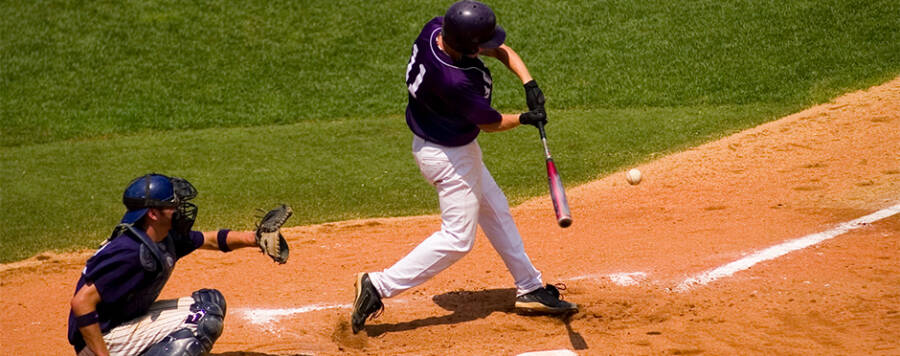In fact, hitting a baseball is one of the most “violent” total body movements in athletics due to multiple body parts moving in synchronization at high angular velocities. As a result, the knee still can become injured. To show the significant amount of torque the body sustains during hitting, it is a good idea to review what happens to the body during this movement.
The Anatomy of a Baseball Hitter
It is important for baseball players to maintain strong legs and core to prevent injury. While there are various stances that a hitter can take, there are some basics that all stances have in common. There is a weight shift from the back leg to the front leg (where power starts). As the upper body starts to rotate, the core is engaged for the hips to begin rotating in unison with the upper body. As contact is made there is significant force generated through the entire body placing significant torque on the knee joint, with the lead leg also going into extension and back leg flexing.
To put this into perspective, the fastest swing (exit velocity) to be recorded is over 123 MPH.3 That is all generated by the body with a majority of the energy coming from the legs and core. With that much force going through the legs (and with torque, extension and flexion happening at the knee), we can now see how a meniscus or collateral ligament could become damaged. If the perfect storm were to happen (i.e. rotating about a fixed leg and hyperextending with foot not moving to help slow forces down) an ACL injury could also occur.
An Ounce of Prevention is Worth a Pound of Cure
To prevent potential injuries, it is very important for baseball players to maintain a healthy and strong core, glutes, hamstrings, quadriceps and lower legs. Since hitting is considered a closed chain activity (feet fixed to the floor), it’s good to perform other strengthening activities in closed chain too.
For example, performing squatting or lunging variations can be great to kick on multiple muscle groups in a functional manner. With that said, it is still important to work open chain as well (feet not fixed to the floor) to establish good hip control and strength because these muscles are the big drivers for the swing.
Athletes can also minimize the risk of ACL injury with Athletico’s ACL 3P Program, where prevention begins with a screening to identify potential injury risk factors that can be corrected. For more information, please email ACL@Athletico.com.
The Athletico blog is an educational resource written by Athletico employees. Athletico bloggers are licensed professionals who abide by the code of ethics outlined by their respective professional associations. The content published in blog posts represents the opinion of the individual author based on their expertise and experience. The content provided in this blog is for informational purposes only, does not constitute medical advice and should not be relied on for making personal health decisions.
1. Fortenbaugh, David, “The Biomechanics of the Baseball Swing” (2011). Open Access Dissertations. 540. http://scholarlyrepository.miami.edu/oa_dissertations/540
2. Welch, Christian M., et al. “Hitting a Baseball: A Biomechanical Description.” Journal of Orthopaedic & Sports Physical Therapy, vol. 22, no. 5, 1995, pp. 193–201., doi:10.2519/jospt.1995.22.5.193.
3. Landers, Chris. “This Giancarlo Stanton Grounder Is the Hardest-Hit Ball Ever Recorded by Statcast.” Major League Baseball, 10 June 2016, m.mlb.com/cutfour/2016/06/10/183198514/giancarlo-stanton-hits-hardest-ball-recorded-by-statcast.
Mike Headtke is a PTA and health mentor who specializes in sports recovery and general fitness to keep people active in the things they enjoy. He enjoys making fitness and wellness fun and easy as its important to keep moving. Watch out for his blogs for some fun tips!

 width="900"
height="356"
>
width="900"
height="356"
>

1 Comment
Bob Nowicki
Mike:
Good stuff!! As a parent of an ACL kid as you well know, it’s great to see any discussion around this devastating injury brought to the forefront. Wish I had the knowledge I have now on the subject. Not sure what the reference 3 P program is but if you’re involved it’s has to be awesome. Good luck and thanks once again for all your help with Jo over the years and trying to keep Dad sane during the process…. 3 years as a college starter, should be a member of the 1000 kill club if all go well next season thanks to a lot of your hard work getting her healthy and back on the court. These programs should be in every gym, club, high school in America as far as I’m concerned. No one knows until you’ve lived it how life changing they can be to all involved. I wish someone would have done it in Volleyball Clubs 5 years ago.
You’ll be amazed to hear which I certainly am that a grad assistant trainer at USF is all over the girls about the way they are jumping with buckled knees, landing on one leg, generally showing concern and trying to correct poor movements related to ACL injuries.
Keep up the great work brother, – you’re the best
Hope all is well my friend.
Great Blog